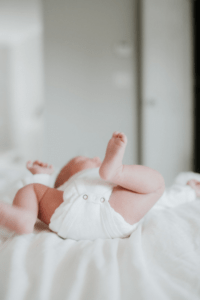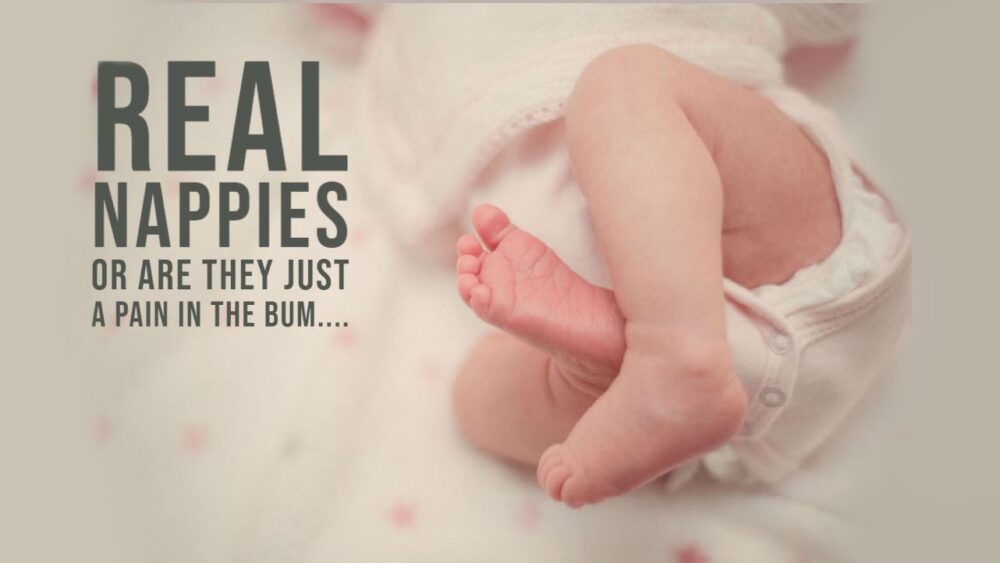Babies poo. They poo a lot. They can poo several times a day in the first few weeks. Not to mention wee, they do that a lot too. In fact, a newborn can average around 12 nappy changes in 24 hours! Indeed, on average, a baby will need about 4,000 nappy changes before they’re fully potty trained. That’s a lot of nappies to be changed, which makes it a big part of a parent’s daily routine. So let’s talk nappies, the reusable vs disposable debate.
Spin it or Bin it
Disposable nappies first became available in the UK in the 1950s. Ask your grandparents and no doubt they’ll tell you that when their babies were in nappies the only poo-catching option was a to use a real cloth nappy. ‘Ugghh!’ we might think now. ‘How did you cope with the smell, the mountains of laundry, the general hassle of it all?’ We might think it so old fashioned, as we whip off another poo-filled disposable nappy and quickly and easily pop it in the bin, never to be seen again.
Initially unpopular, the use of disposables grew over time, to the point where now, in the UK alone, an estimated 3 billion used nappies are thrown away every year. That’s quite a lot of landfill. Especially when you consider it’s estimated that disposable nappies take up to 500 years to decompose. Yes it’s true, some disposables are more environmentally friendly than others, but there is no disposable nappy currently on the market that is 100% biodegradable.
Although reusables have a reputation as harder work than a disposables, there are now many versions that are more attractive than they used to be, and are also easier to wash. Plus, as they’re often made of natural materials, they are kind to baby’s skin.
Real Nappies: Don’t Pooh-Pooh The Idea
We know that disposable nappies are no friend to the environment. But are they a friend to a pushed-for-time parent who appreciates their convenience? And what about their bank balance?
Cost: Disposables you buy as and when you need them, so you don’t need to find a lot of cash up front. There is a higher start-up cost with reusables, and that will vary greatly depending on the type you choose and where you buy them. You also have to consider the costs of laundry. Some local authorities in the UK will give you a ‘real nappy’ voucher or a free sample kit to get you started, or you can hire them. In the long run, over the nappy-wearing life of your baby using reusable nappies can save you hundreds of pounds, even moreso if you have more than one child. Also, once your child is toilet-trained is a big second-hand market so you can sell on your reusables and make some money back.
Convenience: It cannot be denied that disposable nappies win hands down over reusables for convenience. They don’t need to be washed, they don’t need to be dried, you don’t need access to a washing machine. Disposables are considered to be more sanitary, they are slim and light and easy to transport. They can also be more absorbent, and so can mean you need to change baby’s bum less often. Cloth ones require time, effort and energy to keep them laundered. You need to be able to store your used ones whilst out and about until you can bring them home to wash them. It can also be tricky to find baby clothes to fit over reusable nappies, depending on their size and design. You may find you need to go up a size to fit over their larger nappy-covered bottom, or look for companies, such as Frugi, that sell clothing to fit over a cloth nappy.
Real Mums’ Thoughts…
Sara, mum of two: “When I had my firstborn I received a free starter pack of six cloth nappies. By the time my NCT friends had donated their unwanted packs to me I had a stock of 30 nappies. I felt like an eco-warrior! I easily got into a routine of washing the used ones every two or three days and it wasn’t difficult. No special equipment required – I used flushable liners for ‘solids’ – and it didn’t smell. I washed the nappies and popped them out on the lie to dry, so the sunlight bleached them. And the more you reuse them the better they get, more absorbent each time, and they never leaked. With my second child I used a combination, half and half. I would use disposables if we were out for the day or going on holiday as it was one less thing to organise, but would use real nappies at home. They have pros and cons. Cloth nappies have way more cuteness factor! And they hold baby’s hips in a good position. Neither of my two ever had any nappy rash, but then I did change them more often. And I found the older generation loved that I was using them, but then they understood them. But I needed childcare when my child was one year old and I found childminders didn’t have space to store the used nappies. I also found other people were reluctant to use cloth ones, because they were unsure what to do. But I can think of no reason why I shouldn’t use cloth nappies. I would definitely recommend them to anyone, and without a doubt would use them again.”
Karen, mum of two: “I chose to use disposable nappies for both my boys. I was given a starter pack of real cloth nappies with my first baby, but it all seemed like too  much hassle to me when just coping with a newborn was as much as I could handle. I didn’t need the extra work, or the extra washing. However, looking back, if I had that time again, I would definitely give cloth nappies a go. I’d hope to use them for at least some of the time if not all. Disposables just create so much landfill. I do feel guilty now that I didn’t even try real nappies. I think a combination would work best for me. Then at least I could say I did my bit to help the planet.”
much hassle to me when just coping with a newborn was as much as I could handle. I didn’t need the extra work, or the extra washing. However, looking back, if I had that time again, I would definitely give cloth nappies a go. I’d hope to use them for at least some of the time if not all. Disposables just create so much landfill. I do feel guilty now that I didn’t even try real nappies. I think a combination would work best for me. Then at least I could say I did my bit to help the planet.”
Clare, mum of three: “I used solely cloth nappies with my first daughter. I didn’t find them difficult, and could manage the washload without too much trouble. Then, with my second daughter, I used cloth nappies in combination with disposables. I was used to what was required and happy to use cloth nappies with her. But there were times when I just needed the added convenience, if we were having a day out for example. Then with our third child, I found I was using disposables almost all the time. I simply did not have the time, with three young children, to cope with the extra washing and extra planning etc. But I feel I certainly did my bit to help the environment with all the nappies I reused with my first two. I would certainly recommend to anyone to give cloth nappies a try.”
Nappies: what a load of old …?
So, it is no surprise to conclude that reusable real cloth nappies are a lot better for the environment. Plus they do save you money in the long run compared to standard disposable ones. However, they do require more effort, and at a time when your hands are – literally – full, that may not be something you find possible.
The type of nappy you use for your child is a personal choice, one that has to take a number of factors into consideration; convenience, time, money, and the environmental impact. In short, whatever works best for you and your baby is the right choice, whether it’s disposables, reusables or a combination of the two.
 Useful Links
Useful Links
If you would like information with regards to newborn studio portraits then check out my newborn photography page which gives you a great insight into how the sessions run.







Comments are closed.